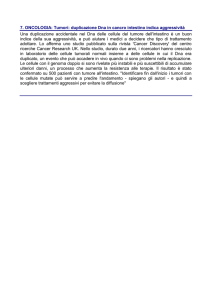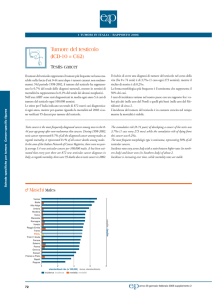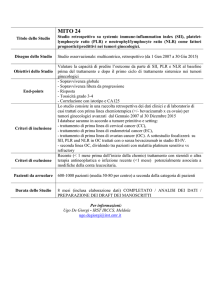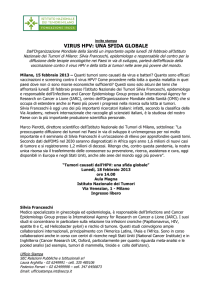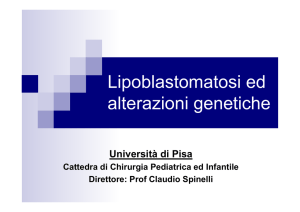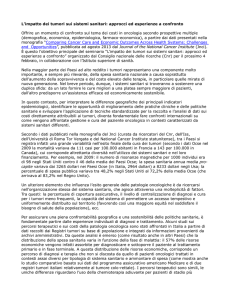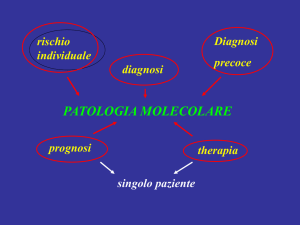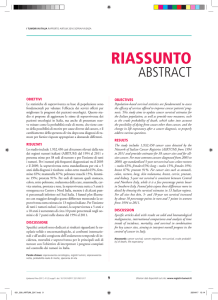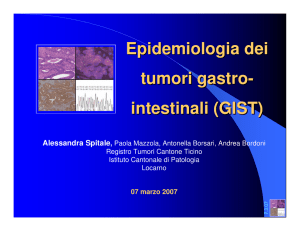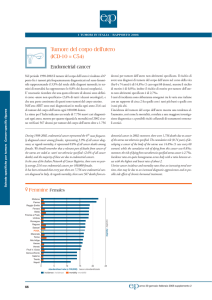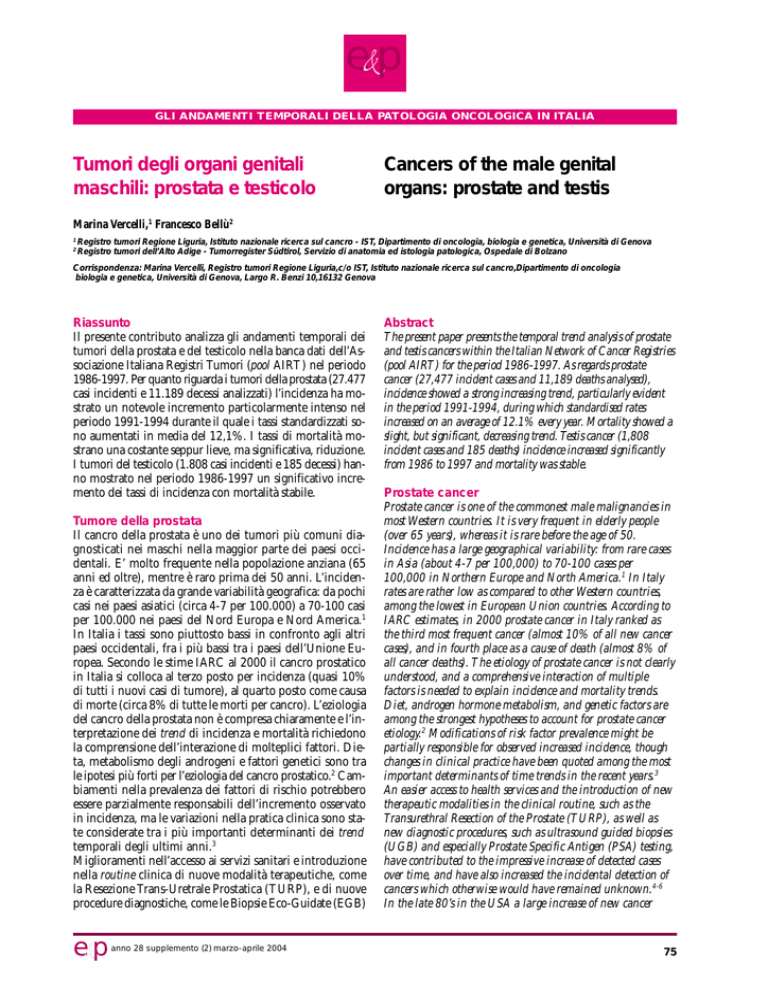
e&p
GLI ANDAMENTI TEMPORALI DELLA PATOLOGIA ONCOLOGICA IN ITALIA
Tumori degli organi genitali
maschili: prostata e testicolo
Cancers of the male genital
organs: prostate and testis
Marina Vercelli,1 Francesco Bellù2
1
2
Registro tumori Regione Liguria, Istituto nazionale ricerca sul cancro - IST, Dipartimento di oncologia, biologia e genetica, Università di Genova
Registro tumori dell’Alto Adige - Tumorregister Südtirol, Servizio di anatomia ed istologia patologica, Ospedale di Bolzano
Corrispondenza: Marina Vercelli, Registro tumori Regione Liguria,c/o IST, Istituto nazionale ricerca sul cancro,Dipartimento di oncologia
biologia e genetica, Università di Genova, Largo R. Benzi 10,16132 Genova
Riassunto
Il presente contributo analizza gli andamenti temporali dei
tumori della prostata e del testicolo nella banca dati dell’Associazione Italiana Registri Tumori (pool AIRT) nel periodo
1986-1997. Per quanto riguarda i tumori della prostata (27.477
casi incidenti e 11.189 decessi analizzati) l’incidenza ha mostrato un notevole incremento particolarmente intenso nel
periodo 1991-1994 durante il quale i tassi standardizzati sono aumentati in media del 12,1%. I tassi di mortalità mostrano una costante seppur lieve, ma significativa, riduzione.
I tumori del testicolo (1.808 casi incidenti e 185 decessi) hanno mostrato nel periodo 1986-1997 un significativo incremento dei tassi di incidenza con mortalità stabile.
Tumore della prostata
Il cancro della prostata è uno dei tumori più comuni diagnosticati nei maschi nella maggior parte dei paesi occidentali. E’ molto frequente nella popolazione anziana (65
anni ed oltre), mentre è raro prima dei 50 anni. L’incidenza è caratterizzata da grande variabilità geografica: da pochi
casi nei paesi asiatici (circa 4-7 per 100.000) a 70-100 casi
per 100.000 nei paesi del Nord Europa e Nord America.1
In Italia i tassi sono piuttosto bassi in confronto agli altri
paesi occidentali, fra i più bassi tra i paesi dell’Unione Europea. Secondo le stime IARC al 2000 il cancro prostatico
in Italia si colloca al terzo posto per incidenza (quasi 10%
di tutti i nuovi casi di tumore), al quarto posto come causa
di morte (circa 8% di tutte le morti per cancro). L’eziologia
del cancro della prostata non è compresa chiaramente e l’interpretazione dei trend di incidenza e mortalità richiedono
la comprensione dell’interazione di molteplici fattori. Dieta, metabolismo degli androgeni e fattori genetici sono tra
le ipotesi più forti per l’eziologia del cancro prostatico.2 Cambiamenti nella prevalenza dei fattori di rischio potrebbero
essere parzialmente responsabili dell’incremento osservato
in incidenza, ma le variazioni nella pratica clinica sono state considerate tra i più importanti determinanti dei trend
temporali degli ultimi anni.3
Miglioramenti nell’accesso ai servizi sanitari e introduzione
nella routine clinica di nuove modalità terapeutiche, come
la Resezione Trans-Uretrale Prostatica (TURP), e di nuove
procedure diagnostiche, come le Biopsie Eco-Guidate (EGB)
e&p
anno 28 supplemento (2) marzo-aprile 2004
Abstract
The present paper presents the temporal trend analysis of prostate
and testis cancers within the Italian Network of Cancer Registries
(pool AIRT) for the period 1986-1997. As regards prostate
cancer (27,477 incident cases and 11,189 deaths analysed),
incidence showed a strong increasing trend, particularly evident
in the period 1991-1994, during which standardised rates
increased on an average of 12.1% every year. Mortality showed a
slight, but significant, decreasing trend. Testis cancer (1,808
incident cases and 185 deaths) incidence increased significantly
from 1986 to 1997 and mortality was stable.
Prostate cancer
Prostate cancer is one of the commonest male malignancies in
most Western countries. It is very frequent in elderly people
(over 65 years), whereas it is rare before the age of 50.
Incidence has a large geographical variability: from rare cases
in Asia (about 4-7 per 100,000) to 70-100 cases per
100,000 in Northern Europe and North America.1 In Italy
rates are rather low as compared to other Western countries,
among the lowest in European Union countries. According to
IARC estimates, in 2000 prostate cancer in Italy ranked as
the third most frequent cancer (almost 10% of all new cancer
cases), and in fourth place as a cause of death (almost 8% of
all cancer deaths). The etiology of prostate cancer is not clearly
understood, and a comprehensive interaction of multiple
factors is needed to explain incidence and mortality trends.
Diet, androgen hormone metabolism, and genetic factors are
among the strongest hypotheses to account for prostate cancer
etiology.2 Modifications of risk factor prevalence might be
partially responsible for observed increased incidence, though
changes in clinical practice have been quoted among the most
important determinants of time trends in the recent years.3
An easier access to health services and the introduction of new
therapeutic modalities in the clinical routine, such as the
Transurethral Resection of the Prostate (TURP), as well as
new diagnostic procedures, such as ultrasound guided biopsies
(UGB) and especially Prostate Specific Antigen (PSA) testing,
have contributed to the impressive increase of detected cases
over time, and have also increased the incidental detection of
cancers which otherwise would have remained unknown.4-6
In the late 80’s in the USA a large increase of new cancer
75
GLI ANDAMENTI TEMPORALI DELLA PATOLOGIA ONCOLOGICA IN ITALIA
INCIDENCE
year
1986
1987
1988
1989
1990
1991
1992
1993
1994
1995
1996
1997
period
EAPC
95% C.I.
Period
EAPC
95% C.I.
period
EAPC
95% C.I.
number
of cases
males
1368
1449
1577
1641
1800
1804
2079
2658
2908
3212
3435
3546
MORTALITY
standardised number
rate
of deaths
males
males
47.3
49.4
50.7
50.6
51.4
49.7
56.4
65.3
70.7
75.2
79.3
81.0
1986-1991
+0.9
-0.4;+2.4
1991-1994
+12.1
+6.6;+17.8
1994-1997
+4.4
+2.3;+6.6
703
774
807
789
927
988
929
997
1048
1066
1081
1080
standardised
rate
males
25.3
27.5
26.3
24.3
26.9
27.1
25.3
24.5
25.1
24.6
24.2
23.9
1986-1997
-0.9
-1.6;-0.2
Tabella 1. Tumore della prostata. Numero di casi, di decessi, tassi standardizzati
(pop. europea) di incidenza e mortalità x 100.000, stima del cambiamento annuo
percentuale dei tassi (EAPC) con i limiti di confidenza al 95%, per anno.
Table 1. Prostate cancer. Number of cases, deaths, standardised (European population) incidence and mortality rates x 100,000, estimated annual percent change
(EAPC) with 95% confidence intervals, by year.
e soprattutto il test dell’Antigene Prostatico Specifico (PSA),
hanno contribuito all’imponente crescita del numero di diagnosi nel tempo, che ha incrementato anche la scoperta accidentale di tumori che sarebbero rimanti altrimenti latenti.4-6 Nei tardi anni ’80 negli USA si osservò un ampio incremento di nuove diagnosi di cancro, principalmente in
relazione alla vasta diffusione del test PSA. Pochi anni più
tardi (1992-1993) seguì una forte diminuzione.3,7 Il trend
di mortalità non mostrò però un andamento simile: negli
ultimi trentacinque anni, dopo un sostenuto incremento e
un successivo livellamento, i tassi hanno iniziato a scendere tra il 1990 e 1995.8
Nei dati del pool dell’Associazione Italiana Registri Tumori
(pool AIRT) i tassi di incidenza di tumore della prostata sono quasi raddoppiati dal 1986 al 1997, passando da 47,3 a
81,0. Il trend è in crescita: debolmente dal 1986 al 1991, con
un cambiamento medio annuo stimato (EAPC) di +0,9%,
in rapida accelerazione dal 1991 al 1994 (EAPC=+12,1%),
in crescita più moderata (EAPC=+4,4%) dal 1994 al 1997.
Il tasso di mortalità era 25,3 nel 1986, è 23,9 nel 1997; il relativo trend si presenta, quindi, in debole ma significativo de-
76
diagnoses was observed, mostly as a consequence of the large
use of PSA testing. A few years later (1992-1993) a sharp
decrease followed.3, 7 Mortality trend did not show a similar
behaviour: during the last 35 years, after a substantial
increase and a subsequent plateau, rates have started to
decrease between 1990 and 1995.8
Incidence data from the pool of the Italian Network of
Cancer Registries (pool AIRT) have almost doubled from
1986 to 1997, changing from 47.3 to 81.0. An increasing
trend is evident: slow from 1986 to 1991, the estimated
annual percent change (EAPC) was +0.9%, rapidly
accelerating from 1991 to 1994 (EAPC = +12.1%), rather
moderate (EAPC = +4.4%) from 1994 to 1997. Mortality
rate was 25.3 in 1986, and 23.9 in 1997; the corresponding
trend thus shows a slow, but statistically significant, decrease
(EAPC-0.9%/year) (Table 1).
When incidence trends are analysed by age category, the
increase is evident in every age group, but is slight in 4559ers, and more relevant in the older age groups, for which a
difference is evident: for 60-74ers the trend is rather stable
until 1991 and a rapid increase follows; in men over 75 years
the increase begins in 1986 but is steeper beyond 1991
(Figure 1). As far as mortality is concerned, younger subjects
show flat trends, 60-74ers show a slight decrease, the older
group shows a slight increase until 1994 which becomes a
rapid decrease thereafter (Figure 2).
Incidence trends by birth cohort show an increase starting
with the 1934-37 cohort: previous cohorts show increasingly
sharp increments, which have a different gradient before and
after 1991 (Figure 3).
Comparing survival results of cases detected between 1986
and 1989 with those detected between 1990 and 1994, a
progressive improvement of prognosis is evident: this is more
evident at five years (from 50 to 67%), less evident at three
years (from 60 to72%), rather limited at one year (from 82
to 89%) (Figure 4). This finding seems to correspond to a
different behaviour depending on the stage at diagnosis:
besides, cancers at a more advanced stage, usually associated
with a lower survival, show no relevant improvement,
whereas an important improvement in prognosis is evident for
limited stage cancers, even for clinically unapparent ones. As
far as the geographical distribution is concerned, a NorthSouth gradient is evident for both incidence and mortality.
This finding is consistent with the hypothesis of increased
incidence in populations with a major lack of Vitamin D
and lesser sunlight exposure.2 A similar gradient is evident
also for trends: the increase in incidence and the decrease in
mortality is greater in Northern Cancer Registries.9
Italian figures, but for the observed time delay, are consistent
with those from North America and with the increasing
trends recently described in Europe.3,5,10 In fact, in Italy, the
use of PSA testing as a current practice became frequent after
1990 or even later.9
e&p
anno 28 supplemento (2) marzo-aprile 2004
TUMORI DEGLI ORGANI GENITALI MASCHILI
Figura 1. Tumore della prostata. Tassi di incidenza per classi d’età
x 100.000.
Figura 2. Tumore della prostata. Tassi di mortalità per classi d’età
x 100.000.
Figure 1. Prostate cancer. Incidence rates by age-classes x 100,000.
Figure 2. Prostate cancer. Mortality rates by age-classes x 100,000.
cremento (EAPC=-0,9% annuo) (Tabella 1).
Analizzando i trend di incidenza per fascia d’età l’incremento
si avverte in ogni gruppo d’età, ma è debole nei 45-59enni,
più consistente nei due gruppi d’età più anziani. C’è una differenza fra i due: per i 60-74enni il trend fino al 1991 si mostra piuttosto stabile, dopo si osserva un rapido incremento;
negli ultra-settantacinquenni l’incremento inizia dal 1986, ma
si fa più ripido dopo il 1991 (Figura 1).
Per la mortalità i più giovani mostrano trend appiattiti, i 6074enni mostrano un lieve decremento, i più anziani un lieve
incremento fino al 1994, un decremento accentuato successivamente (Figura 2).
Nei trend d’incidenza per coorte di nascita si avverte un incre-
Incidence trends might have been influenced by different
attitudes of urological practitioners towards the use of this test.
Such a behaviour is justified by the absence of a clear cut
consensus as to diagnostic (opportunistic screening) and
therapeutic optimal strategies. A prognostic improvement
might be also associated with the diffusion of effective or new
treatment procedures.11-12 Due to the increased frequency of
localized cancers, potentially curable, a larger number of
patients has been treated by radical prostatectomy and
radiotherapy, and techniques have thus been optimized.11
Moreover, orchidectomy has been rapidly replaced by
hormonal treatment with gonadotropic hormone (GnRH)
analogues, which allowed for an improvement of life quality.13
Figura 3. Tumore della prostata. Tassi di incidenza per classi d’età e coorte
di nascita x 100.000.
Figura 4. Tumore della prostata. Sopravvivenza relativa a 1, 3 e 5 anni
dalla diagnosi per periodo d’insorgenza.
Figure 3. Prostate cancer. Incidence rates by age-classes and birth cohorts
x 100,000.
Figure 4. Prostate cancer. Relative survival at 1, 3 and 5-years after
diagnosis by period of incidence.
e&p
anno 28 supplemento (2) marzo-aprile 2004
77
GLI ANDAMENTI TEMPORALI DELLA PATOLOGIA ONCOLOGICA IN ITALIA
mento a partire dalla generazione 1934-1937: le coorti precedenti fanno registrare incrementi sempre più ripidi, che presentano però diversa pendenza prima e dopo il 1991 (Figura 3).
Mettendo a confronto i risultati di sopravvivenza dei casi diagnosticati nel periodo 1986-1989 rispetto a quelli del 19901994 si osserva un incremento consistente nella prognosi:
più robusto a cinque anni (da 50 a 67%), più contenuto a
tre anni (da 60 a 72%), ridotto a un anno (da 82 a 89%) (Figura 4). Ciò sembrerebbe riflettere un diverso comportamento in base allo stadio alla diagnosi: infatti per gli stadi
più avanzati, tendenzialmente a sopravvivenza minore, non
si registrano consistenti miglioramenti, mentre un notevole
incremento di prognosi caratterizza i tumori a stadio più precoce o, addirittura, clinicamente silenti.
Per quanto riguarda la distribuzione geografica è possibile
osservare un gradiente Nord-Sud, sia per l’incidenza, che per
la mortalità. Questo aspetto sarebbe consistente con le ipotesi di un incremento d’incidenza nelle popolazioni in cui si
riscontra maggiore carenza di vitamina D e minore esposizione alla luce solare.2 Un gradiente simile è evidente anche
per i trend: l’aumento di incidenza e la diminuzione nella
mortalità è maggiore nei RT del Nord.9
I dati italiani, fatto salvo il ritardo temporale osservato, sembrano quindi consistenti con quelli nordamericani e con i
trend in crescita descritti recentemente in Europa.3,5,10 In Italia, infatti, l’utilizzo del test PSA nella pratica clinica ha iniziato a diffondersi dopo il 1990 e anche più tardi.9
I trend d’incidenza potrebbero essere stati influenzati da differenti attitudini dei reparti urologici nell’adottare tale test.
Questo comportamento sarebbe motivato dalla mancanza di
un chiaro consenso, sia rispetto alle pratiche diagnostiche
(screening opportunistico), sia alle strategie di trattamento
ottimale da adottare.
A sua volta il miglioramnto nella prognosi potrebbe essere parzialmente correlato alla diffusione nell’uso di trattamenti efficaci o nuovi.11,12 A causa dell’incremento di cancri localizzati,
potenzialmente curabili, un più ampio numero di pazienti è stato sottoposto a prostatectomia radicale e radioterapia curativa,
di conseguenza le tecniche in uso si sono raffinate.11 Inoltre, l’orchiectomia è stata rapidamente rimpiazzata dalla terapia ormonale con gli analoghi dell’ormone gonadotropinico (GnRH),
che ha anche reso la qualità di vita più accettabile.13
In Italia le differenze nei trend potrebbero quindi essere parzialmente correlate sia a una scarsa disponibilità di tecnologie
mediche, sia a una ridotta consapevolezza sull’efficacia delle
terapie disponibili, sia a una minore attenzione verso la malattia, che è tipica delle aree dove questa è meno comune, come è probabilmente il caso di alcune aree del Sud d’Italia.9
Tumore del testicolo
Il 95-98% di tutte le neoplasie maligne testicolari è costituito da tumori delle cellule germinali del testicolo (TCGT),
che sono il tipo di malignità più comune nei maschi di età
78
In Italy, differences in trends might thus be partially
explained by limited high-tech medical facilities, by a reduced
awareness of the efficacy of available therapies, by a reduced
attention to the disease, typical of areas where the disease is
uncommon, which might well be the case for some areas in
Southern Italy.9
Testis cancer
Germinal cell tumours (TCGT) account for 95-98% of all
testicular malignancies, which are the most common in males
aged 15 to 34 years.14-15 For descriptive purposes these tumours
are grouped in: seminomas, non-seminomas and spermatocytic
seminomas. In the USA these three categories account for
60.8%, 38.8% or 0.6%, respectively and their overall incidence
has increased by 44% from 1973 to 1998: the trend has been
greater for seminomas (increased by 64%), and smaller for nonseminomas (increased by 24% only).14 The mean age of men
with seminoma is approximately ten years greater compared to
non-seminoma (peaks at 30-45 years vs. 20-35 years).
Lymphoma and spermatocytic seminoma are the most frequent
cancers in males over 50 years.15 The incidence of non-seminomas
in adult males increases in subjects below 55 years, and decreases
beyond this age limit, whereas for seminoma the increase of
incidence is evident for both younger and older age groups.16 USA
trends show a period-effect for both seminoma and nonseminoma risk, but the birth cohort-effect is prevalent.14 This
finding is reported also for other populations.15-21 There is no
evidence that the USA increase in seminoma and non-seminoma
rates in white males is related to increased detection: the increase,
on the contrary, is possibly explained by changes in exposure to
presumable etiological factors, either environmental14-21 or
socioeconomical.21-22 Moreover, the incidence of TCGT seems to
be related to the histological type, a continuous increase of risk
Figura 5. Tumore del testicolo. Tassi di incidenza per classi d’età
x 100.000
Figure 5. Testis cancer. Incidence rates by age-classes x 100,000.
e&p
anno 28 supplemento (2) marzo-aprile 2004
TUMORI DEGLI ORGANI GENITALI MASCHILI
INCIDENCE
number
of cases
males
year
1986
1987
1988
1989
1990
1991
1992
1993
1994
1995
1996
1997
period
EAPC
95% C.I.
Period
EAPC
95% C.I.
120
123
123
138
130
134
166
170
166
179
192
167
MORTALITY
standardised number
rate
of deaths
males
males
4.7
4.7
4.5
4.9
4.3
4.4
5.3
5.2
5.0
5.5
5.6
5.0
1986-1997
+1.7
+0.4;+3.1
22
14
13
18
14
15
18
14
19
18
12
8
standardised
rate
males
0.8
0.5
0.5
0.5
0.4
0.5
0.6
0.4
0.6
0.5
0.3
0.2
1986-1995
-2.7
-8.4;+3.3
1995-1997
-32.5
-72.3;+64.2
Tabella 2. Tumore del testicolo. Numero di casi, di decessi, tassi standardizzati (pop.
europea) di incidenza e mortalità x 100.000, stima del cambiamento annuo percentuale dei tassi (EAPC) con i limiti di confidenza al 95%, per anno.
Table 2. Testis cancer. Number of cases, deaths, standardised (European population) incidence and mortality rates x 100,000, estimated annual percent change
(EAPC) with 95% confidence intervals, by year.
15-34 anni.14,15 Ai fini descrittivi tali tumori sono raggruppati in: seminomi, non seminomi e seminomi spermatocitici. Negli USA questi rappresentano rispettivamente il
60,8%, 38,8% e 0,6% e complessivamente la loro incidenza risulta aumentata del 44% tra il 1973 e il 1998: i trend
del seminoma sono saliti del 64%, il non seminoma solo del
24%.14 L’età media alla diagnosi negli uomini con seminoma è circa dieci anni più alta rispetto a quelli con non seminoma (picchi a 30-45 anni vs 20-35 anni). Nei maschi di
età superiore ai 50 anni le principali forme sono il linfoma
e il seminoma spermatocitico.15 L’incidenza dei non seminomi negli adulti cresce nei maschi sotto i 55 anni e diminuisce nei più anziani, mentre per il seminoma c’è incremento d’incidenza sia nei giovani, sia negli anziani.16 Nei
trend statunitensi, sebbene si osservi un effetto periodo sia
per il rischio di seminoma, sia per il non seminoma, l’effetto dominante sembra essere quello della coorte di nascita.14
Tale dato è riportato anche per altre popolazioni.15-21 Non
c’è evidenza che l’incremento secolare statunitense nei tassi di seminoma e non seminoma dei maschi bianchi sia dovuto all’incremento nelle diagnosi: tale aumento sembra invece poter essere spiegato da cambiamenti nell’esposizione
ai presunti fattori eziologici, sia ambientali14-21 che socioeconomici.21-22 Inoltre, l’incidenza di TCGT sembra variare
e&p
anno 28 supplemento (2) marzo-aprile 2004
being evident only for seminoma, whereas trends of nonseminoma are flattening.14 Pregnancy and other maternal
features (e.g. increased oestrogen levels, increased age at delivery,
reduced parity, increased placental weight) seem to be associated
with seminoma in sons more strongly than for non-seminoma.
Non-seminoma, on the contrary, seems to be more closely
associated with indicators of delayed intrauterine growth (e.g.
low weight at birth, low mother age).23 Cryptorchidism,24
prematurity25 and low age at surgery for hernia26 seem to increase
the risk of seminoma. Traumas27 and a history of sexually
transmitted diseases (e.g. HIV)24,27 seem to be directly associated
with increased risk of non-seminoma, whereas delayed puberty
seems to have an inverse association.24 However, it is difficult to
know if the prevalence of any of these variables has changed to a
sufficient extent over time to explain the flattening of nonseminoma trends.14 Additional debated risk factors for testicular
cancer are the so called «endocrine-destroying chemical
agents» (e.g. dioxine, chloride organic compounds, pesticides
and PCB) for which the available evidence suggests a causal
effect in the first years of life, possibly even at intrauterine
level.28-29
In Italy the incidence rate of testicular cancer was 4.7 in 1986,
and is 5 in 1997. The trend thus shows an increase (EAPC = +
1.7 % per year). Mortality rate, on the contrary, was 0.8 in
1986 and has decreased to 0.2 in 1997; the trend showed a not
statistically significant decrease (Table 2).
Trends differ according to age: incidence is slightly decreasing over
the age of 45, whereas it is increasing in the 15-44 years-age
group (Figure 5). Mortality decreases in both age-groups, though
with a greater slope in the elderly (Figure 6).
Birth cohort analysis shows major differences, with variable
behaviour among cohorts, which seems to confirm trends
observed in other countries.14-21
Figura 6. Tumore del testicolo. Tassi di mortalità per classi d’età
x 100.000.
Figure 6. Testis cancer. Mortality rates by age-classes x 100,000.
79
GLI ANDAMENTI TEMPORALI DELLA PATOLOGIA ONCOLOGICA IN ITALIA
per istologia, con un continuo incremento nel rischio solo
per il seminoma, mentre i trend del non seminoma si stanno appiattendo.14 Caratteristiche della gravidanza ed altre caratteristiche materne (es. più elevati livelli di estrogeni, incremento dell’età, diminuita parità, aumento del peso placentare) sembrerebbero nei figli essere più fortemente associate con il seminoma in confronto al non seminoma. Il non
seminoma sembrerebbe, invece, essere più strettamente associato a variabili indicative di ritardo della crescita intrauterina (es. basso peso alla nascita, diminuita età materna)23
Il criptorchidismo,24 la prematurità25 e la precoce età all’intervento per ernia26 sembrerebbero incrementare maggiormente il rischio di seminoma. I traumi27 e la storia di malattie sessualmente trasmesse (es. infezione da HIV)24,27 sarebbero direttamente associati all’aumento di rischio di non
seminoma, mentre la ritardata pubertà sembrerebbe inversamente associata.24 E’ difficile, comunque, conoscere se la
prevalenza di ciascuna di queste variabili sia cambiata abbastanza nel tempo per spiegare l’appiattimento dei trend del
non seminoma.14 Ulteriori fattori di rischio in discussione
per il cancro testicolare sono i cosiddetti agenti chimici endocrino distruttori (es. diossina, organoclorurati, pesticidi e
PCB), per i quali l’evidenza suggerisce effetti causali ad età
molto precoci nella vita, forse anche a livello intrauterino.28,29
In Italia il tasso d’incidenza dei tumori del testicolo che era nel
1986 pari a 4,7 è 5 nel 1997. Il trend si presenta, quindi, in incremento, EAPC=+ 1,7 % annuo. Il tasso di mortalità, invece, era 0,8 nel 1986 ed è sceso a 0,2 nel 1997; il suo trend è,
quindi, in diminuzione sebbene non significativa (Tabella 2).
I trend si differenziano per fascia d’età: l’incidenza è in lieve
diminuzione per i soggetti di età superiore a 45 anni, in incremento nella fascia d’età 15-44 anni (Figura 5). La mortalità diminuisce in entrambe le fasce d’età, con una pendenza maggiore, però, nei più anziani (Figura 6).
L’analisi per coorte di nascita ci rivela profonde differenze,
con andamenti molto variabili fra una coorte e l’altra che
sembrano confermare i trend osservati in altri paesi.14-21 Il
basso numero di casi consiglia, però, cautela nel trarre conclusioni relative al pattern osservato.
Data la curabilità (introduzione nell’uso del cisplatino dopo
il 1977)30 la sopravvivenza dei pazienti con tumore del testicolo si colloca sopra al 90%: come atteso nei pazienti diagnosticati nel periodo 1990-1994 rispetto al 1986-1989 si
osserva solo un debolissimo incremento nella prognosi, sia a
uno che a tre e cinque anni (Figura 7).
La presente analisi si riferisce ai dati dell’Associazione Italiana Registri Tumori (pool AIRT) relativi ai seguenti registri: Registro Tumori del Piemonte
e della Valle d’Aosta, Registro Tumori del Veneto, Registro Tumori della Provincia di Modena, Registro Tumori della Provincia di Parma, Registro Tumori della Provincia di Ragusa, Registro Tumori della Romagna, Registro Tumori Lombardia - Provincia di Varese, Registro Tumori Regione Liguria, Registro Tumori Toscano, e riguardano il periodo 1986-1997.La metodologia
adottata è presentata in questa stessa monografia, in: Stracci F, Sacchettini C.
Gli andamenti temporali della patologia oncologica in Italia: i dati dei registri tumori (1986-1997). Metodi. Epidemiol Prev 2004; 28 (2) suppl: 12-16.
80
Figura 7. Tumore del testicolo. Sopravvivenza relativa a 1, 3 e 5 anni
dalla diagnosi per periodo d’insorgenza.
Figure 7. Testis cancer. Relative survival at 1, 3 and 5-years after diagnosis
by period of incidence.
The limited number of cases, however, suggests some caution in
drawing conclusions from the observed pattern.
Due to the curability of the disease (cisplatin chemotherapy
was introduced in 1977),30 survival of patients with
testicular cancer is over 90%: as expected, a minimal
improvement of prognosis at one, three or five years is
observed for cancers detected during 1990-1994 as compared
to 1986-1989 (Figure 7).
The present analysis refers to the following registries of the Italian Network of
Cancer Registries (pool AIRT): Registro Tumori del Piemonte e della Valle
d’Aosta, Registro Tumori del Veneto, Registro Tumori della Provincia di
Modena, Registro Tumori della Provincia di Parma, Registro Tumori della
Provincia di Ragusa, Registro Tumori della Romagna, Registro Tumori
Lombardia - Provincia di Varese, Registro Tumori Regione Liguria, Registro
Tumori Toscano, and to the period 1986-1997. The methods are described
in this monography in: Stracci F, Sacchettini C. Cancer trends in Italy:
figures from the Cancer Registries (1986-1997). Methods. Epidemiol Prev
2004; 28 (2) suppl: 12-16.
Bibliografia - References
1.
2.
3.
4.
5.
6.
7.
8.
Ferlay J, Bray F, Pisani P, Parkin DM. GLOBOCAN 2000: Cancer incidence,
mortality and prevalence worldwide, version 1.0. IARC CancerBase n.5. Lyon,
IARC Press, 2001.
Hanchette CL, Schwartz GG. Geographic patterns of prostate cancer mortality. Cancer, 1992; 70: 2861-69.
Potosky AL, Feuer EJ, Levin DL. Impact of screening on incidence and
mortality of prostate cancer in the United States. Epidemiol Rev, 2001; 1:
181-86.
Mettlin C. Recent developments in the epidemiology of prostate cancer.
Eur J Cancer, 1997; 33: 340-47.
Merril RM, Potosky AL, Fewer EJ. Changing trends in U.S. prostate cancer incidence rates. J Natl Cancer Inst, 1996; 88: 1683-85.
Potosky AL. Rise in prostatic cancer incidence associated with increased use
of transurethral resection. J Natl Cancer Inst, 1990; 82: 1624-1628.
Stephenson RA, Smart CR, Mineau GP, James BC, Janerich DT, Dibble
R. The fall in incidence of prostate carcinoma. Cancer, 1995; 77: 1342-8.
Surveillance, Epidemiology, and End Results (SEER) Program. Age-adjusted U.S. cancer death rates. J Natl Cancer Inst, 1997; 89: 12.
e&p
anno 28 supplemento (2) marzo-aprile 2004
TUMORI DEGLI ORGANI GENITALI MASCHILI
9.
10.
11.
12.
13.
14.
15.
16.
17.
18.
19.
20.
Quaglia A, Parodi S, Grosclaude P, Martinez Garcia C, Coebergh JW, Vercelli M. Differences in the epidemic rise and decrease of prostate cancer
among geographical areas in Southern Europe: an analysis of differential
trends in incidence and mortality in France, Italy and Spain. Eur J Cancer,
2003; 39: 645-665.
Vercelli M, Quaglia A, Marani E, Parodi S. Prostate cancer incidence and
mortality trends among elderly and adult Europeans. Crit Rev Onc Hem,
2000; 35: 133-144.
Mettlin C, Murphy GP. Why is the prostate cancer death rate declining in
the United States?. Cancer, 1998; 82: 249-251.
Mettlin C. Changes in patterns of prostate cancer care in the United States: results of American College of Surgeons Commission on Cancer Study,
1974-1993. Prostate, 1997; 32: 221-6.
Small EJ. Advances in prostate cancer, Curr Opin Oncol, 1999; 11: 226-35.
McGlynn KA, Devesa SS, Sigurdson AJ, Brown LM, Tsao L, Tarone RE.
Trends in the incidence of testicular germ cell tumors in the United States,.Cancer, 2003; 97: 63-70.
Huyghe E, Matsuda T, Thonneau P. Increasing incidence of testicular cancer worldwide: a review. J Urol, 2003; 170: 5-11.
dos Santos Silva I, Swerdlow AJ, Stiller CA, Reid A. Incidence of testicular
germ-cell malignancies in England and Wales: trends in children compared with adults. Int J Cancer, 1999; 83: 630-4.
McKiernan JM, Goluboff ET, Liberson GL, Golden R, Fisch H. Rising risk of testicular cancer by birth cohort in the United States from 1973 to
1995. J Urol, 1999; 162: 361-3.
Moller H. Trends in incidence of testicular cancer and prostate cancer in
Denmark. Hum Reprod, 2001; 16: 1007-11.
Ekbom A, Richiardi L, Akre O, Montgomery SM, Sparen P. Age at immigration and duration of stay in relation to risk for testicular cancer among
Finnish immigrants in Sweden. J Natl Cancer Inst, 2003; 95: 1238-40.
Liu S, Semenciw R, Waters C, Wen SW, Mery LS, Mao Y. Clues to the ae-
e&p
anno 28 supplemento (2) marzo-aprile 2004
21.
22.
23.
24.
25.
26.
27.
28.
29.
30.
tiological heterogeneity of testicular seminomas and non-seminomas: time
trends and age-period-cohort effects. Int J Epidemiol, 2000; 29: 826-31.
Levi F, La Vecchia C, Boyle P, Lucchini F, Negri E. Western and eastern
European trends in testicular cancer mortality. Lancet, 2001; 357: 185354.
Pukkala E, Weiderpass E. Socio-economic differences in incidence rates of
cancers of the male genital organs in Finland, 1971-95. Int J Cancer, 2002;
102: 643-8.
Akre O, Ekbom A, Hsieh CC, Trichopoulos D, Adami HO. Testicular nonseminoma amd seminoma in relation to prenatal characteristics. J Natl Cancer Inst, 1996; 88: 883-889.
Coupland CA, Chilvers CE, Davey G, Pike MC, Oliver RT, Forman D.
Risk factors for testicular germ cell tumours by histological tumour type.
United Kingdom Testicular Cancer Study Group. Br J Cancer, 1999; 80:
1859-63.
Moller H, Skakkebaek NE. Testicular cancer and cryptorchidism in relation to prenatal factors: case-control studies in Denmark. Cancer Causes
Control, 1997; 8: 904-912.
Swerdlow AJ, Huttly SRA, Smith PG. Testicular cancer and antecedent diseases. Br J Cancer, 1987; 55: 97-103.
Frisch M, Biggar RJ, Engels EA, Goedert JJ. Association of cancer with
Aids-related immunosuppression in adults. JAMA, 2001; 285: 1736-45.
Toledano MB, Jarup L, Best N, Wakefield J, Elliott P. Spatial variation and
temporal trends of testicular cancer in Great Britain. Br J Cancer, 2001; 84:
1482-7.
Sharpe RM, Skakkebaek NE. Are estrogens involved in falling sperm
counts and disorders of the male reproductive tract?. Lancet, 1993; 341:
1392-5.
Einhorn LH, Donohue J. Cis-Diamminedichloroplatinum, vinblastine and
bleomycin combination chemostherapy in disseminated testicular cancer.
Ann Intern Med, 1977; 87: 293-8.
81

